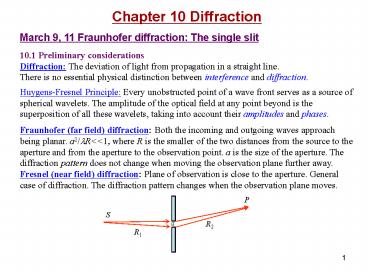Chapter 10 Diffraction - PowerPoint PPT Presentation
1 / 28
Title:
Chapter 10 Diffraction
Description:
Chapter 10 Diffraction March 9, 11 Fraunhofer diffraction: The single slit 10.1 Preliminary considerations Diffraction: The deviation of light from propagation in a ... – PowerPoint PPT presentation
Number of Views:185
Avg rating:3.0/5.0
Title: Chapter 10 Diffraction
1
Chapter 10 Diffraction March 9, 11 Fraunhofer
diffraction The single slit 10.1 Preliminary
considerations Diffraction The deviation of
light from propagation in a straight line. There
is no essential physical distinction between
interference and diffraction. Huygens-Fresnel
Principle Every unobstructed point of a wave
front serves as a source of spherical wavelets.
The amplitude of the optical field at any point
beyond is the superposition of all these
wavelets, taking into account their amplitudes
and phases. Fraunhofer (far field) diffraction
Both the incoming and outgoing waves approach
being planar. a2/lRltlt1, where R is the smaller of
the two distances from the source to the aperture
and from the aperture to the observation point. a
is the size of the aperture. The diffraction
pattern does not change when moving the
observation plane further away. Fresnel (near
field) diffraction Plane of observation is close
to the aperture. General case of diffraction. The
diffraction pattern changes when the observation
plane moves.
2
Mathematical criteria for Fraunhofer
diffraction The phase for the rays meeting at
the observation point is a linear function of the
aperture variables.
Waves from a point source Harmonic spherical
wave
A is the source strength.
Coherent line source
eL is the source strength per unit length. This
equation changes a diffraction problem into an
integration (interference) problem.
3
10.2 Fraunhofer diffraction 10.2.1 The single slit
The slit is along the z-axis and has a width of D.
4
(No Transcript)
5
Phasor model of single slit Fraunhofer
diffraction rolling paper
6
Read Ch10 1-2 Homework Ch10 3,7,8,9 Due
March 27
7
March 23 Double slit and many slits
10.2.2 The double slit
The result is a rapidly varying double-slit
interference pattern (cos2a) modulated by a
slowly varying single-slit diffraction pattern
(sin2b/b 2).
8
Question Which interference maximum coincides
with the first diffraction minimum?
Half-fringe (split fringe) may occur there. Our
author counts a half-fringe as 0.5 fringe.
9
10.2.3 Diffraction by many slits
10
(No Transcript)
11
Phasor model of three-slit interference rotating
sticks
12
Read Ch10 2 Homework Ch10 10,11,12 Due April
3
13
March 25 Rectangular aperture
10.2.4 The rectangular aperture
Coherent aperture
X
Fraunhofer diffraction condition
14
Rectangular aperture
15
(No Transcript)
16
Read Ch10 2 Homework Ch10 14,17 Due April 3
17
March 27 Circular aperture
10.2.5 The circular aperture
Importance in optical instrumentation The image
of a distant point source is not a point, but a
diffraction pattern because of the limited size
of the lenses.
Bessel functions.
18
Radius of Airy disk
19
Read Ch10 2 Homework Ch10 25,28 Due April 3
20
March 30 Resolution of imaging systems
10.2.6.0 Equivalence between the far field and
the focal plane diffraction pattern
Two coherent point sources
- This applies to any number of arbitrarily
distributed point sources in space. - Far field and focal plane produce the same
diffraction pattern, but with different sizes. - R is replaced by f in the focal plane pattern.
- ?A lens pulls a far-field diffraction pattern to
its focal plane, reduces the size by f/R.
21
10.2.6 Resolution of imaging systems
Image size of a circular aperture
Rayleighs criterion for bare resolution The
center of one Airy disk falls on the first
minimum of the other Airy disk. We can actually
do a little better.
Image size of a far point source
Angular limit of resolution
Overlap of two incoherent point sources
22
Angular limit of resolution
Wavelength dependence CD? DVD
Question Comparing the circular with the square
aperture, why does the square aperture produce a
smaller diffraction pattern? (l/D vs. 1.22 l/D)
23
Read Ch10 2 No homework
24
April 1, 3 Gratings
Diffraction grating An optical device with
regularly spaced array of diffracting
elements. Transmission gratings and reflection
gratings. Grating equation
25
Grating spectroscopy
Angular width for a spectral line N-slit
interference
Angular dispersion
26
Limit of resolution
Barely resolved two close wavelengths
Resolving power
(Dq)width
Question Why does the resolving power increase
with increasing order number and with increasing
number of illuminated slits?
27
Free spectral range
l lDl
In higher order diffraction the spectrum is more
spread in angle. This results in a higher
resolving power but a narrower free spectral
range.
28
Read Ch10 1-2 Homework Ch10
32,33,34,39,41 Due April 10































